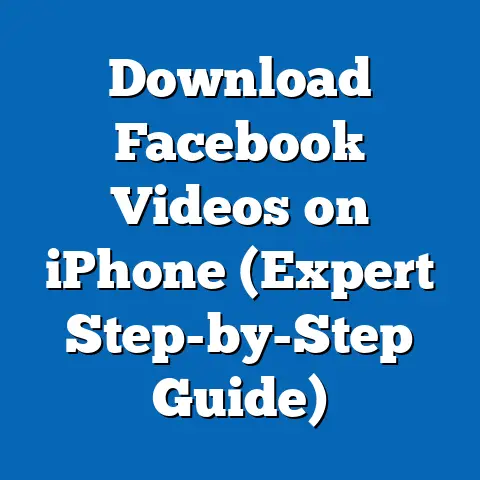Spotting Fake Ads on Facebook Marketplace (Essential Guide)
Facebook Marketplace has revolutionized how we buy and sell goods, seamlessly integrating into our daily lives. I remember when it first launched; it seemed like a simple way to declutter my apartment. Little did I know, it would evolve into a bustling digital bazaar where you can find everything from vintage furniture to the latest gadgets. Its rapid growth is undeniable, becoming a go-to resource for individuals and businesses alike. The convenience and accessibility it offers are unparalleled, allowing users to connect directly and transact without the complexities of traditional e-commerce platforms.
However, this convenience comes with its own set of challenges. The rise of fraudulent activity, particularly fake ads, has cast a shadow on the platform’s trustworthiness. These deceptive listings not only undermine the integrity of the marketplace but also affect both buyers and sellers who rely on it for legitimate transactions. Imagine finding the perfect car at an unbelievable price, only to realize it’s a scam designed to steal your money. It’s a frustrating and disheartening experience, and unfortunately, it’s becoming increasingly common.
Section 1: Understanding Facebook Marketplace
Facebook Marketplace is more than just a virtual garage sale; it’s a dynamic e-commerce platform integrated directly within the Facebook ecosystem. It operates by connecting buyers and sellers within their local communities, making it easy to find and purchase items nearby. The platform’s features are designed to facilitate seamless transactions, from browsing listings to communicating with sellers and arranging pick-ups.
At its core, Facebook Marketplace leverages user profiles, allowing you to see who you’re dealing with. This adds a layer of transparency that’s often missing in other online marketplaces. The built-in messaging system enables direct communication with sellers, allowing you to ask questions, negotiate prices, and coordinate logistics. While Facebook doesn’t directly handle payments for most transactions, it does offer options like Facebook Pay in some regions, providing a secure way to transfer funds.
The types of products commonly sold on Facebook Marketplace are incredibly diverse. You can find everything from electronics and clothing to furniture, appliances, and even vehicles. I’ve personally seen listings for rare collectibles, handmade crafts, and even services like landscaping and home repair. This wide range of offerings makes it a one-stop-shop for many consumers.
The demographic of users on Facebook Marketplace is equally diverse, appealing to a wide range of age groups and interests. From college students furnishing their dorm rooms to families looking to upgrade their homes, the platform attracts a broad audience. According to recent statistics, millennials and Gen Z are particularly active on Facebook Marketplace, driven by its convenience and affordability. However, older demographics are also increasingly using the platform to buy and sell goods, making it a truly intergenerational marketplace.
Takeaway: Facebook Marketplace is a powerful e-commerce platform that offers convenience and accessibility to a wide range of users. Understanding its features, diverse offerings, and growing impact is crucial for navigating it safely and effectively.
Section 2: The Rise of Fake Ads
Unfortunately, the popularity of Facebook Marketplace has also attracted a darker element: the rise of fake ads. These deceptive listings are designed to scam unsuspecting buyers out of their money, and their prevalence on the platform is a growing concern.
The prevalence of fake ads on Facebook Marketplace is alarming. Data from various consumer protection agencies indicates a significant increase in fraudulent activities over recent years. In 2023 alone, reports of scams on Facebook Marketplace rose by over 50%, highlighting the urgent need for increased awareness and prevention. I’ve even seen reports from friends who’ve nearly fallen victim to these scams, sharing their stories of near-misses and the tactics used by scammers.
The motivations behind creating fake ads are primarily financial gain. Scammers aim to trick buyers into sending money for products they will never receive. They often target high-value items like electronics, vehicles, and designer goods, knowing that buyers are willing to spend more on these items. The promise of a great deal can cloud judgment, making people more susceptible to scams.
Scammers employ a variety of tactics to create fake ads, often preying on buyers’ emotions and vulnerabilities. One common tactic is using stolen images. They lift photos from legitimate websites or social media accounts to create convincing listings. Another tactic is creating false urgency. They might claim that the item is in high demand or that they are moving soon and need to sell it quickly. This pressure can push buyers into making hasty decisions without properly vetting the seller or the product.
Impersonating legitimate businesses or individuals is another common tactic. Scammers might create fake profiles that mimic those of established sellers, making it difficult to distinguish between genuine and fraudulent listings. They might even use fake reviews or testimonials to build trust, further deceiving potential victims.
Takeaway: The rise of fake ads on Facebook Marketplace is a serious issue, driven by financial gain and facilitated by various deceptive tactics. Recognizing these tactics is the first step in protecting yourself from scams.
Section 3: Key Characteristics of Fake Ads
Identifying fake ads on Facebook Marketplace requires a keen eye and a bit of skepticism. By understanding the common traits of these deceptive listings, you can significantly reduce your risk of falling victim to a scam. Here are some key characteristics to watch out for:
Unusual Prices
One of the most obvious red flags is a price that seems too good to be true. Scammers often lure buyers in with unbelievably low prices, knowing that it will attract attention. If a product is listed for significantly less than its market value, it’s a strong indication that something is amiss.
I remember seeing a listing for a brand-new iPhone that was priced hundreds of dollars below retail. It seemed like an incredible deal, but my instincts told me to be cautious. Sure enough, after doing some research, I discovered that the seller was using stolen images and had a history of fraudulent activity. If it sounds too good to be true, it probably is.
Poor Quality Images
Fake ads often use images that are blurry, stolen, or not representative of the product. Scammers might lift photos from other websites or social media accounts, without actually possessing the item themselves. These images are often low-resolution or poorly cropped, making it difficult to assess the product’s condition.
Pay close attention to the details in the images. Are there any inconsistencies or signs of tampering? Does the background match the seller’s location? If something seems off, it’s best to err on the side of caution. Conducting a reverse image search can also help you determine if the images are being used elsewhere online.
Vague Descriptions
Another telltale sign of a fake ad is a vague or incomplete product description. Scammers often avoid providing specific details about the item, as they may not actually have it in their possession. They might use generic phrases or copy-paste descriptions from other websites, without tailoring them to the specific product.
Legitimate sellers typically provide detailed descriptions that include information about the product’s condition, features, and history. They are also willing to answer questions and provide additional information upon request. If a seller is unwilling or unable to provide specific details about the product, it’s a red flag.
Limited Seller Information
Fake ads often originate from profiles with limited or suspicious information. Scammers might create fake accounts using stolen identities or generic names, without providing any personal details or contact information. These profiles often have few or no friends, followers, or past activity.
Legitimate sellers typically have detailed profiles that include their name, location, and contact information. They might also have reviews or testimonials from past buyers, providing social proof of their trustworthiness. Before engaging with a seller, take the time to research their profile and look for any red flags.
Urgency Tactics
Scammers often create a false sense of urgency to pressure buyers into making hasty decisions. They might claim that the item is in high demand or that they are moving soon and need to sell it quickly. This pressure can cloud judgment and lead buyers to overlook red flags.
Be wary of sellers who try to rush you into making a purchase. Legitimate sellers are typically patient and understanding, allowing you to take your time and ask questions. If a seller is pushing you to make a decision quickly, it’s a sign that something is amiss.
Takeaway: By understanding these key characteristics of fake ads, you can significantly improve your ability to identify and avoid scams on Facebook Marketplace. Always be skeptical, pay attention to the details, and trust your instincts.
Section 4: How to Verify Authenticity
Once you’ve identified a listing that seems suspicious, it’s time to put on your detective hat and verify its authenticity. Here’s a step-by-step guide on how to do just that:
Research the Seller
Your first step should be to thoroughly research the seller. Start by checking their profile on Facebook Marketplace. Look for the following:
- Profile Photo: Does the profile have a photo? Is it a clear image of a real person, or is it a generic image or logo?
- Friends and Followers: How many friends and followers does the seller have? A profile with very few friends or followers could be a red flag.
- Past Activity: Has the seller been active on Facebook for a long time, or is the account relatively new? A new account with limited activity could be suspicious.
- Reviews: Does the seller have any reviews or ratings from past buyers? Positive reviews can be a good sign, but be wary of generic or overly enthusiastic reviews, which could be fake.
- Listings: What other items has the seller listed for sale? Do the listings seem consistent and legitimate, or are they a mix of unrelated items?
If anything seems off about the seller’s profile, it’s best to proceed with caution.
Reverse Image Search
One of the most effective ways to verify the authenticity of a listing is to conduct a reverse image search. This involves uploading the product images to a search engine like Google Images or TinEye, which will then search the web for other instances of the same image.
If the image appears on multiple websites or social media accounts, it could be a sign that the seller is using stolen images. Pay close attention to the context in which the image is being used. Is it being used in connection with a legitimate business or individual, or is it being used in a suspicious or fraudulent manner?
I once used reverse image search to uncover a scam involving a vintage motorcycle. The seller had listed the motorcycle for an unbelievably low price, and the images looked legitimate. However, when I conducted a reverse image search, I discovered that the same images were being used on a classic motorcycle forum, where the bike was being offered for sale at a much higher price. It was clear that the seller was using stolen images to create a fake listing.
Ask Questions
Engaging with the seller by asking specific questions about the product is another important step in verifying authenticity. Legitimate sellers are typically happy to answer questions and provide additional information, while scammers often avoid providing details or become defensive.
Here are some questions you might consider asking:
- Product Condition: Can you provide more details about the product’s condition? Are there any scratches, dents, or other imperfections?
- Product History: How long have you owned the product? Why are you selling it?
- Product Features: Can you describe the product’s key features and specifications?
- Additional Images: Can you provide additional images of the product from different angles?
- Meet in Person: Would you be willing to meet in person to show me the product?
Pay close attention to the seller’s responses. Are they prompt and informative, or are they vague and evasive? Do they seem knowledgeable about the product, or do they struggle to answer basic questions? If anything seems suspicious, it’s best to proceed with caution.
Check for Payment Methods
Finally, be sure to check the seller’s preferred payment methods. Scammers often request payment through unconventional methods, such as gift cards, wire transfers, or cryptocurrency, which are difficult to trace and offer little buyer protection.
Legitimate sellers typically accept payment through secure methods like PayPal, credit cards, or cash in person. These methods offer buyer protection and make it easier to recover your funds if something goes wrong.
I always avoid sellers who insist on payment through unconventional methods. It’s a major red flag and a strong indication that the listing is a scam.
Takeaway: By following these steps to verify the authenticity of a listing, you can significantly reduce your risk of falling victim to a scam on Facebook Marketplace. Always do your research, ask questions, and use secure payment methods.
Section 5: Reporting and Avoiding Scams
Even with the best precautions, you might still encounter a fake ad or even fall victim to a scam on Facebook Marketplace. Knowing how to report these incidents and protect yourself in the future is crucial.
Reporting Fake Ads
If you come across a listing that you believe is a fake ad, it’s important to report it to Facebook immediately. Here’s how:
- Navigate to the Listing: Find the ad in question on Facebook Marketplace.
- Click the Three Dots: Look for the three dots in the upper-right corner of the listing.
- Select “Report Listing”: Choose the “Report Listing” option from the drop-down menu.
- Choose a Reason: Select the reason why you are reporting the listing. Options might include “Fake Product,” “Scam,” or “Misleading Information.”
- Provide Details: Add any additional details or comments that might help Facebook investigate the listing.
- Submit the Report: Click the “Submit” button to send the report to Facebook.
Facebook will review the report and take appropriate action, which might include removing the listing, suspending the seller’s account, or even reporting the seller to law enforcement.
What to Do If You’ve Been Scammed
If you’ve already fallen victim to a scam on Facebook Marketplace, it’s important to take immediate action to minimize the damage. Here are some steps you should take:
- Contact Your Bank or Credit Card Company: If you paid for the item using a credit card or debit card, contact your bank or credit card company immediately to report the fraud. They may be able to reverse the charges or issue a refund.
- Report the Scam to Facebook: Report the scam to Facebook using the steps outlined above. Provide as much detail as possible, including the seller’s name, the listing details, and any communication you had with the seller.
- Report the Scam to Authorities: Report the scam to your local police department or the Federal Trade Commission (FTC). They may be able to investigate the scam and take action against the perpetrators.
- Change Your Passwords: If you used the same password for Facebook and other online accounts, change your passwords immediately to prevent further fraud.
- Monitor Your Credit Report: Keep a close eye on your credit report for any signs of identity theft or unauthorized activity.
Tips for Protecting Yourself in Future Transactions
To protect yourself from scams in future transactions on Facebook Marketplace, consider the following tips:
- Meet in Public Places: When possible, meet the seller in a public place to inspect the item and complete the transaction. Avoid meeting at the seller’s home or in a secluded location.
- Bring a Friend: Bring a friend or family member along when meeting the seller. Having a second set of eyes can help you spot red flags and avoid making hasty decisions.
- Inspect the Item Carefully: Before handing over any money, inspect the item carefully to ensure that it matches the description and is in good condition.
- Use Secure Payment Methods: Use secure payment methods like PayPal, credit cards, or cash in person. Avoid using unconventional methods like gift cards, wire transfers, or cryptocurrency.
- Trust Your Instincts: If something feels off about a listing or a seller, trust your instincts and walk away. It’s better to miss out on a deal than to fall victim to a scam.
Takeaway: Reporting fake ads and taking steps to protect yourself from scams is essential for maintaining a safe and trustworthy online shopping environment on Facebook Marketplace.
Section 6: Educating Others
Combating fake ads on Facebook Marketplace is not just an individual responsibility; it’s a community effort. By spreading awareness and sharing your knowledge, you can help protect others from falling victim to scams.
The Importance of Spreading Awareness
Fake ads thrive in an environment of ignorance and misinformation. Many people are simply unaware of the tactics used by scammers, making them more vulnerable to deception. By educating others about the risks and warning signs, you can empower them to make safer choices.
I make it a point to share my experiences and knowledge with my friends and family. I’ve warned them about the dangers of unbelievably low prices, vague descriptions, and unconventional payment methods. I’ve also shown them how to conduct reverse image searches and research sellers. By sharing this information, I hope to help them avoid falling victim to scams.
Sharing Your Experiences
Sharing your own experiences with fake ads and scams can be a powerful way to educate others. Whether you’ve encountered a suspicious listing or fallen victim to a scam, your story can help others learn from your mistakes.
Consider sharing your experiences on social media, in online forums, or in community newsletters. Be sure to provide specific details about the scam, including the seller’s name, the listing details, and any communication you had with the seller. By sharing your story, you can help others recognize similar scams and avoid becoming victims themselves.
Community Initiatives and Online Forums
Another way to educate others about fake ads is to participate in community initiatives and online forums. These platforms provide a space for people to share information, ask questions, and support each other in the fight against scams.
Consider joining or creating an online forum dedicated to Facebook Marketplace scams. In this forum, people can share their experiences, report suspicious listings, and offer advice to others. You could also organize community workshops or seminars to educate people about the risks of online scams and how to protect themselves.
Takeaway: Educating others about fake ads on Facebook Marketplace is a crucial step in combating fraud and maintaining a safe and trustworthy online shopping environment. By spreading awareness, sharing your experiences, and participating in community initiatives, you can help protect others from falling victim to scams.
Conclusion
Navigating Facebook Marketplace can be a rewarding experience, offering access to a wide range of products at competitive prices. However, it’s essential to approach the platform with caution and vigilance, especially given the prevalence of fake ads.
Throughout this guide, I’ve emphasized the importance of understanding the tactics used by scammers and learning how to verify the authenticity of listings. By recognizing the key characteristics of fake ads, such as unusually low prices, poor quality images, and vague descriptions, you can significantly reduce your risk of falling victim to a scam.
I’ve also provided a step-by-step guide on how to verify the authenticity of a listing, including researching the seller, conducting a reverse image search, asking questions, and checking for secure payment methods. By following these steps, you can make informed decisions and avoid making hasty purchases.
Finally, I’ve discussed the importance of reporting fake ads and taking steps to protect yourself in future transactions. By reporting suspicious listings to Facebook and using secure payment methods, you can help maintain a safe and trustworthy online shopping environment.
In conclusion, understanding and identifying fake ads is crucial for safer transactions on Facebook Marketplace. Vigilance and education are key to maintaining the integrity of the platform. I encourage you to apply the knowledge gained from this article to your future buying and selling experiences on Facebook Marketplace. By doing so, you can protect yourself and contribute to a safer online shopping environment for everyone. Happy shopping!





